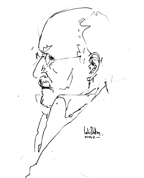Thomas A. Moore
Artificial Photosynthesis and Bio-inspired Catalysis: Paradigms For Sustainable Energy Production
Energy security is an issue facing humanity that is no less significant than war, famine, disease, overpopulation, the plight of refugees and the guarantee of human rights across the lands. In the First World, energy is largely supplied by fossil fuels; the developing world is following this example with a vengeance. It is now certain that the continued consumption of fossil fuels is unsustainable and that humans are, in fact, doing a global-scale experiment in climate change. In order to avoid the uncertain, but likely, catastrophic outcome of this experiment, it is necessary to convert to carbon-free energy sources on a massive scale in the near future. It is the responsibility of technologically advanced societies to lead the way in the conversion-a process made all the more difficult because the usual driver of such change, pure short-term economics, will continue to favor fossil fuels for the foreseeable future. It can be argued convincingly that solar is the only source currently available that could supply the tens of terawatts of carbon-free energy that must be produced before 2050 to make global energy production sustainable.
Nature’s photosynthetic process is the premier solar energy conversion process on earth; it provides paradigms for sustainable global energy production and efficient energy transformations. The combination of mechanistic and structural information available for energy producing and consuming biological structures serves to guide organic, inorganic and materials chemists in their efforts to abstract and mimic the active elements of nature’s energy processing constructs and press them into human-directed service. Towards these ends, in our laboratory we have designed a number of artificial photosynthetic constructs and assembled them into energy converting systems.
For example, carotenoid pigments and even polymer polyenes can be incorporated into chlorophyll-based artificial reaction centers capable of converting solar energy into chemical energy. In certain cases the light harvesting function of these artificial carotenoid antennas is near 100% efficient. In increasingly complex systems, artificial ion pumps based on Mitchellian redox loops have been assembled that demonstrate net solar to chemical potential energy conversion, including the synthesis of ATP. A hybrid photoelectrochemical cell has been developed that uses NAD-linked dehydrogenase enzymes to oxidize a variety of biomaterials and uses light to boost the reduction potential of the resulting electrons sufficiently to reduce protons to H2 at neutral pH.
In fact, the bioenergetic processes that make life possible for oxygen-breathing organisms involve reactions common to the fuel cells that hold promise for efficient energy conversion in human-made devices. The enzymes that carry out these reactions in living cells operate at high efficiency and can inspire the development of efficient catalysts for the splitting of water, the reduction of oxygen to water and the oxidation of hydrogen to protons, reactions that are right at the heart of sustainable energy production and consumption. Progress in a number of laboratories towards the development of these bioinspired catalysts is encouraging, but still far from practical application. The number one concern is, are we as a society willing to think long-term, to commit research funding and infrastructure investment at a much higher level, even on a par with Health and Human Services or the Department of Defense, to provide real energy security?
Thomas A. Moore, Ph.D.
Director, ASU Center for Bioenergy & Photosynthesis



